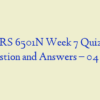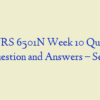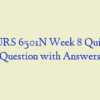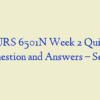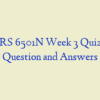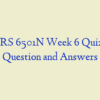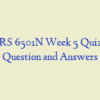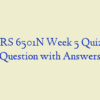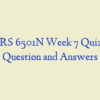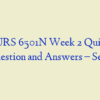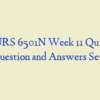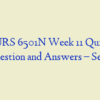Description
NURS 6501 Midterm Exam – Question and Answers (Spring Term)
- What is the blood type of a person who is heterozygous, having A and B alleles as codominant?
- The data reporting that sickle cell disease affects approximately 1 in 600 American blacks is an example of which concept?
- A patient is having a spirometry measurement done and asks the healthcare professional to explain this test. What response by the professional is best?
- A healthcare professional is caring for a patient undergoing chemotherapy. What is the skin-related health risk the professional should assess the patient for and be prepared to treat?
- A professor has taught the students about the sources of increased ammonia in patients with hepatic encephalopathy. What statement by a student indicates the professor should review this material?
- What-is the second most commonly recognized genetic cause of intellectual disability?
- What is the role of reverse transcriptase in HIV infection?
- Which renal change is found in older adults?
- In regulating vascular mediators released from mast cells, the role of eosinophils is to release what?
- Under anaerobic conditions, what process provides energy for the cell?
- A patient had a motor vehicle crash and suffered critical injuries to the brainstem. What physiological responses would the healthcare professional expect to see?
- A parent wants to know how to prevent type 1 diabetes in the newborn. The healthcare professional explains that prevention is not possible, because which of these is a major characteristic of type 1 diabetes mellitus?
- A patient has a pulmonary capillary wedge pressure of 30mmHg. What assessment finding by the healthcare professional would be most consistent with this reading?
- A patient is having an IgE-mediated hypersensitivity reaction. What action by the healthcare professional is best?
- A healthcare professional is educating a patient on asthma. The professional tells the patient that the most successful treatment for chronic asthma begins with which action?
- A student asks the healthcare professional to explain the pathophysiologic process of alcoholic cirrhosis. What statement by the professional would not be consistent with complete knowledge about this process?
- The pathophysiologic process of edema is related to which mechanism?
- How does progressive nephron injury affect angiotensin II activity?
- A student asks the professor to explain what effect natriuretic peptides have during heart failure when the heart dilates. Which response by the professor is best?
- When renin is released, it is capable of which action?
- What is the initiating event that leads to the development of atherosclerosis?
- The glomerular filtration rate is directly related to which factor?
- What mechanisms occur in the liver cells as a result of lipid accumulation?
- A person wants to know if eating only plant-based foods is advisable as a way to cut cholesterol to near-zero levels. What response by the health care professional is best?
- The Bainbridge reflex is thought to be initiated by sensory neurons in which cardiac location?
- A patient has a serum sodium level of 165 mEq/L. The healthcare professional explains that the clinical manifestations of confusion, convulsions, cerebral hemorrhage, and coma are caused by what mechanism?
- A person has hypothyroidism. What chemical does the healthcare professional advise the person to include in the diet?
- During the cardiac cycle, why do the aortic and pulmonic valves close after the ventricles relax?
- If a patient develops acidosis, the nurse would expect the oxyhemoglobin dissociation curve to react in which manner?
- What does vomiting-induced metabolic alkalosis cause?
- What is one function of the tumor cell marker?
- A patient suffered multiple traumatic injuries and received many blood transfusions within a few days of the injuries. For which medical condition should the healthcare professional monitor the patient for?
- A pregnant woman has Graves disease. What test/s does the healthcare professional advise the woman about?
- A healthcare professional is caring for a patient who has a delay in electrical activity reaching the ventricle as seen on ECG. What ECG finding would the healthcare professional associate with this problem?
- A healthcare professional tells a student that a patient has lost atrial kick. What would the student expect to see when examining this patient?
- A patient has diabetes mellitus. A recent urinalysis showed increased amounts of protein. What therapy does the healthcare provider educate the patient that is specific to this disorder?
- A healthcare professional is caring for four patients. Which patient does the professional assess for neurogenic diabetes insipidus (DI)?
- How do free radicals cause cell damage?
- A student studying biology asks the professor to describe how the ras gene is involved in cancer proliferation. What explanation by the professor is best?
- A patient has a peptic ulcer related to h. pylori bacteria. What treatment does the healthcare professional educate the patient on?
- A patient in the hospital has hypernatremia. What condition should the healthcare professional assess for?
- A patient is in severe shock and is receiving vasopressin. A student asks the health care professional to explain the rationale for this treatment. What response by the professional is most accurate?
- A student is preparing to irrigate a patient’s wound and gathers supplies, including hydrogen peroxide. What response by the health care professional is best?
- A healthcare professional care for older adults in a skilled nursing facility.
- What should the professional assess for in these individuals related to cardiovascular functioning?
- Which statement made by a student indicates the healthcare professional needs to describe the pericardium again?
- Where is two-thirds of the body’s water found?
- A healthcare professional is caring for four patients. Which patient does the professional assess for pulmonary emboli (PE) as the priority?
- A patient has been diagnosed with a renal stone. Based on knowledge of common stone types, what self-care measure does the healthcare professional plan to teach the patient when stone analysis has returned?
- What is the inflammatory effect of nitric oxide (NO)?
- What is the cause of familial hypercholesterolemia (FH)?
- During acidosis, the body compensates for the increase in serum hydrogen ions by shifting hydrogen ions into the cell in exchange for which electrolyte?
- Which chamber of the heart endures the highest pressures?
- When endothelial cells are injured, what alteration contributes to atherosclerosis?
- What is the cause of functional dysphagia?
- A patient diagnosed with diabetic ketoacidosis (DKA) has the following laboratory values: arterial pH 7.20; serum glucose 500 mg/dL; positive urine glucose and ketones; serum potassium (K +) 2 mEq/L; serum sodium (Na +) 130 mEq/L. Thepatient reports that he has been sick with the flu for 1 week. What relationship do these values have to his insulin deficiency?
- What is one function of the tumor cell marker?
- A student asks about the mechanism that results in type II hypersensitivity reactions. What description by the professor is best?
- What physical sign does the healthcare professional relate to the result of turbulent blood flow through a vessel?
- Which hormone is require for water to be reabsorbed in the distal tubule and collecting duct?
- A patient asks the healthcare professional why tissue damage occurs in acute rejection after organ transplantation. What response by the professional is best?
- What are blood pressure variations associate with?
- A class of students has learned about contributing factors to duodenal ulcers. What statement indicates to the professor that the students need a review?
- Renal failure is the most common cause of which type of hyperparathyroidism?
- An amniocentesis indicates a neural tube defect when an increase in which protein is evident?
- A healthcare professional wants to determine the adequacy of a person’s alveolar ventilation. What assessment finding is most important for the professional to consider?
- What is an expected change in the cardiovascular system that occurs with aging?
- Oxygenated blood flows through which vessel?
- A patient’s urinalysis came back positive for glucose. What does the healthcare professional expect the patient’s blood glucose to be at a minimum?
- A student asks the healthcare professional to explain the function of the papillary muscles. What response by the professional is best?
- The healthcare professional explains to a student that the amount of volume of blood in the heart is directly related to the of contraction.
- A healthcare professional is caring for a patient who has continuous increases in left ventricular filing pressures. What disorder would the professional assess the patient for?
- What pathologic change occurs to the kidney’s glomeruli as a result of hypertension?
- A student asks why some vaccinations are given orally and some are given by injection. What response by the professor is best?
- A patient has a history of excessive use of magnesium-containing antacids and aluminum-containing antacids. What lab value does the healthcare professional correlate to this behavior?
- A student asks the healthcare professional to describe exotoxins. Which statement by the professional is best?
- What are tumor cell markers?
- The acute inflammatory response is characterized by a fever that is produced by the hypothalamus being affected by what?
- A healthcare professional is educating a patient about asthma. The professional states that good control is necessary due to which pathophysiologic process?
- The student asks the professor to explain what characteristic is demonstrated by lungs with decreased compliance?
- The action of platelet-derived growth factor is to stimulate the production of which cells?
- A healthcare professional tells the student that a properly placed endotracheal tube for mechanical ventilation is 5 to 7 cm above the tracheal bifurcation. Where does this bifurcation occur?
- Surfactant produced by type II alveolar cells facilitates alveolar distention and ventilation by which mechanism?
- A patient is brought to the Emergency Department with a gunshot wound to the chest. The healthcare professional assesses an abnormality involving a pleural rupture that acts as a one-way valve, permitting air to enter on inspiration but preventing its escape by closing during expiration. What action by the healthcare professional is the priority?
- A professor has taught the students about the pathogenesis of abdominal pain. Which statement by a student indicates the professor needs to review the material?
- People diagnosed with neurofibromatosis have varying degrees of the condition because of which genetic principle?
- A student asks the professor how a faulty negative-feedback mechanism results in a hormonal imbalance. What response by the professor is best?
- A healthcare professional is working with a person who drinks several 6-packs of beer a week. What testing does the professional encourage the person to get?
- Which characteristic is the most important determinant of immunogenicity when considering the antigen?
- A patient has portal hypertension-induced splenomegaly. Which lab value would the healthcare professional associate with this condition?
- Why is leakage of lysosomal enzymes during chemical injuries significant?
- What is the most important cause of pulmonary artery constriction?
- Autocrine stimulation is the ability of cancer cells to do what?
- Neurotransmitters affect the postsynaptic membrane by binding to which structure?
- A healthcare provider notes that tapping the patient’s facial nerve leads to lip twitching. What electrolyte value is correlate with this finding?
- During cell injury caused by hypoxia, why does an increase in the osmotic pressure within the cell occur?
- A female patient has been diagnose with an uncomplicated urinary tract infection. What self-care measure does the healthcare provider teach the patient that is specific to this type of infection?
- A healthcare professional is conducting community education on vaccinations. Which statement about vaccines does the professional include in the presentation?
- A patient reports dumping syndrome after a partial gastrectomy. What does the healthcare professional teach this patient?
- Once they have penetrated the first line of defense, which microorganisms do natural killer (NK) cells actively attack?
- Free radicals play a major role in the initiation and progression of which diseases?



